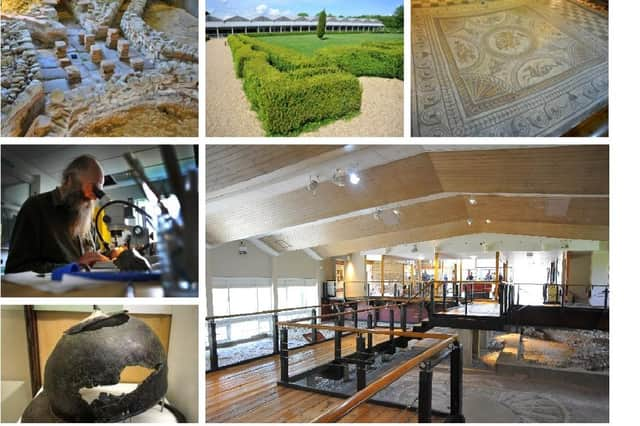The Fishbourne home of Britain's archaeological jewel


Fishbourne's Roman Palace is one of Britain's most well preserved and puzzling Roman remains. Potentially possessing a footprint larger than Buckingham Palace, Fishborne’s world-famous relic provides an insight into Roman life that very few archaeological sites can match.
Dr Rob Symmons is the curator of the Roman Palace and has been looking after the site for 16 years, and his passion for the previously deluxe dwelling has been undiminished over the years.
Advertisement
Hide AdAdvertisement
Hide AdHe said: “A significant part of my job is encouraging other people to fly kites and come up with new theories and ideas about the Roman settlement, and I love hearing them and coming up with my own ideas as well. I really like supporting experts and students and facilitating their research; that’s what gets me up in the morning”.
Dr Symmons also protects the collections and makes them accessible to the public in the best possible way, with members of his team currently digitising its projector slides and photographing all of the coins so they can be available online.
Thanks to the pioneering work of Barry Cunliffe in excavating the Roman Palace in the 1960s, many groundbreaking developments have been made over the years. Such as the discovery of a Roman Oyster helmet, which appears to confirm the theory that the Romans had contact with the Sussex coastline well before the Roman conquest of Britain in 47AD.
Dr Symmons said: “We have started to realise that when the Romans originally came to Britain, it wasn't an invasion with ballistas and barracks, it was more of a political advance, and the more we look, the more we see that there was a pre-conquest presence here.
Advertisement
Hide AdAdvertisement
Hide Ad“It suggests a much richer influence and relationship with the Romans from before the invasion than had previously been believed. The image of Britain being a mysterious place to the Romans is inaccurate, certainly for places like Fishbourne.
“Neither did the Celts look over the channel and not know who or what was there; they will have met them, may have married them, but certainly traded with them.”
Despite the groundbreaking discoveries and the vast amount of history held within Fishbourne Roman Palace, Dr Symmons is also very much looking forward and has suggested exciting developments on the horizon for the West Sussex archaeological site.
Other highlights in the palace are the mosaic of Cupid riding a dolphin, one of the best-preserved Roman mosaics in the world, which historian Dan Snow has described as ‘one of the most remarkable I have ever seen’. There is also the formal Roman garden, which is extraordinary because in no other place in the world can viewers see the exact location and design of the Roman Formal Garden.
Advertisement
Hide AdAdvertisement
Hide AdThe palace was constructed around 30 years after the Roman invasion in 75AD, and it would have had a considerable impact on the local tribes, particularly the formal garden. Never before had nature and the wilderness been controlled in such a manner; it was previously regarded as a sacred area that one's deceased ancestors and wild beings inhabited.
Dr Symmons said: "If you want to send a message to somebody that you are in charge, you occupy their cathedral, so that's what the Romans did. They were stamping their presence on the pre-existing culture. It was a form of domination.”
In 280 AD a fire caused irreparable damage to the dwelling resulting in its occupants fleeing and the palace being reclaimed by the wilderness. It is not known what exactly started the fire but it is not believed to be the unused hypocaust (a system of underfloor central heating) as once thought.
Nowadays, the Roman Palace is one of many sites administered by the Sussex Archeological Society (also known as Sussex Past), which was first established in 1846 and is the oldest county archaeological society in Britain. During the pandemic, the palace and the rest of Sussex Past’s establishments were under threat, but thanks to a campaign led by historian Tom Holland and the generosity of its members, the society managed to survive the lockdowns.
Advertisement
Hide AdAdvertisement
Hide AdMr Holland said: "Fishbourne Roman Palace is of immense significance, not only in Sussex and in Britain — it is of huge international significance as well.
Dr Symmons expressed his pleasure at the response the palace received: “Over lockdown, the support we got was amazing; it was quite touching. People were queuing around the carpark.”
The palace is open from 10 am to 5 pm seven days a week, and tickets cost £12 for adults, £6 for students and children, family tickets cost £35, and senior tickets are £11.50.
Coming up at the Roman Palace is a Celts vs The Romans event for half term. Between 11 am and 3 pm from May 30 to June 3, there will be interactive activities for children to enjoy whilst learning about how the Romans and Celts lived. Then the Ermine Street Guard will visit for a weekend of fun-filled activities as they demonstrate the capabilities of the Roman army and its equipment.
Advertisement
Hide AdAdvertisement
Hide AdDr Symmons said: “It is such fun to watch; they fire cabbages out of siege weapons. This time we are hoping to bring a couple of cavalrymen on horses as well.”
For more information on Sussex Past’s events, visit sussexpast.co.uk